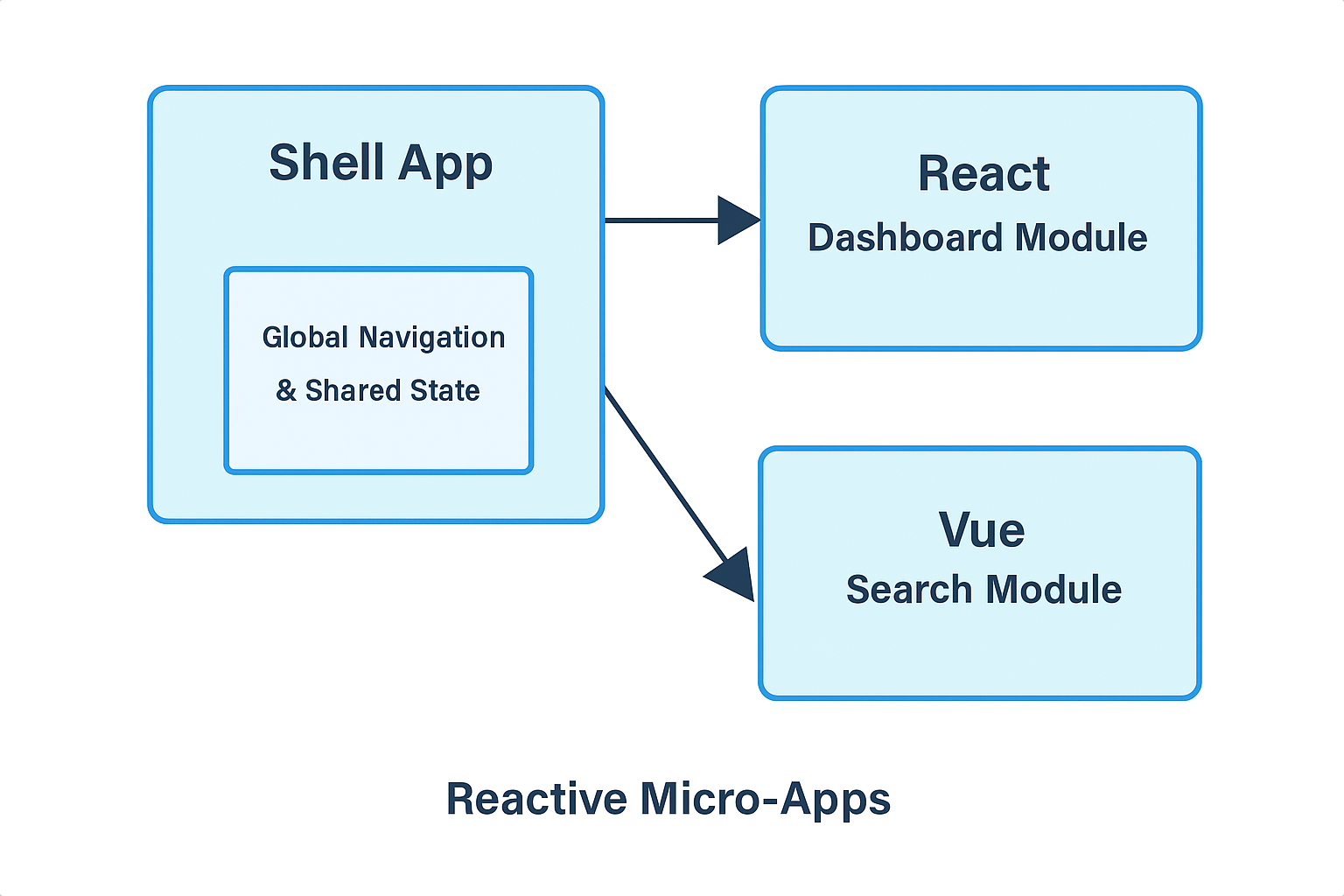Introduction
As web applications grow, monolithic frontends—where all features live in a single codebase— quickly become difficult to manage. Large applications like dashboards, search systems, user management, and analytics often suffer from:
- Slow build and deployment cycles
- Conflicts between multiple teams working on the same codebase
- Difficulty introducing new frameworks or technologies
- Risk of a single failure breaking the entire application
Micro-Frontends offer a solution. Inspired by microservices on the backend, Micro- Frontends break the UI into independent, self-contained modules, each owned by a different team. This allows teams to develop, deploy, and scale features independently while maintaining a seamless experience for users.
What are Micro-Frontends?
At its core, a Micro-Frontend is a frontend application divided into smaller, independently deployable units. Each unit:
- Handles a specific business domain (e.g., dashboard, search, user management)
- Can be built with its own framework (React, Vue.js, Angular, etc.)
- Maintains its own build and deployment pipeline.
- Communicates with other modules through well-defined contracts or events.
Unlike a monolith, micro-frontends allow multiple teams to work autonomously without stepping on each other’s toes.
How Micro-Frontends Work
Architecture Overview
- Shell / Container App: Hosts global navigation, shared state, authentication, and top-level routes. Dynamically loads micro-apps at runtime.
- Micro-Apps: Independently developed modules like a dashboard, search, or user management. Each exposes a mount/unmount interface.
- Shared Libraries: Optional shared utilities (React, Vue, CSS frameworks) to reduce bundle duplication.
Generation of Micro-Frontends
- Create a Standalone Module: Independent project with its own dependencies, routing (if needed), and state management.
- Expose Mount Function: The shell uses this to render the module dynamically.
- Share Common Libraries: Use Module Federation or similar to avoid multiple framework instances.
- Teams can use different frameworks (React, Vue) without conflicts
- Independent builds → faster CI/CD
- Easy incremental adoption of new technologies
Lifecycle & Integration
- Mount: Shell calls of the micro-app; app initializes state and renders UI.
- Update: Micro-app reacts to events, user interactions, or route changes.
- Unmount: When navigating away, shell calls to remove the micro-app cleanly.
- Routing-based state: Share information via URL params (e.g., selected filters).
- Custom events / Event Bus: Publish-subscribe mechanism between micro-apps.
- Shared Services: Lightweight APIs for global data or state synchronization.
A typical Micro-Frontend architecture consists of:
Illustration:
Shell App
├─ React Dashboard Module
├─ Vue Search Module
└─ React User Management Module
The shell dynamically loads micro-apps based on route or user interaction. This ensures independent deployment while presenting a unified UI.
Reactive Micro-Apps Architecture

When generating a micro-frontend:
Benefits of this approach:
Micro-Frontends follow a mount-update-unmount lifecycle:
Communication:-
This architecture ensures that failure in one module does not affect the entire application, increasing reliability.
Real-Life Example: Dashboard + Search
Imagine a SaaS platform:
- React Dashboard Module: Displays metrics, KPIs, and charts.
- Vue Search Module: Filters and searches datasets displayed in the dashboard.
- Shell App: Hosts top-level routes /dashboard and /search
React Dashboard Module(Simplified)
import React, { useState, useEffect } from "react";
export default function ReactDashboard() {
const [metrics, setMetrics] = useState([]);
useEffect(() => {
setTimeout(() => {
setMetrics([
{ name: "Active Users", value: 120 },
{ name: "Revenue", value: "$5,200" },
]);
console.log("Dashboard loaded!");
}, 200);
}, []);
return (
<div>
<h2>Analytics Dashboard</h2>
<ul>
{metrics.map(m => (
<li key={m.name}>{m.name}: {m.value}</li>
))}
</ul>
</div>
);
}
Explanation:
- Shell mounts the module dynamically.
- Simulated data fetch populates the dashboard.
- React state ensures UI updates automatically.
Vue Search Module (Simplified)
<template>
<div>
<input v-model="query" placeholder="Search metrics..." />
<ul>
<li v-for="item in filteredMetrics" :key="item.name">
{{ item.name }}: {{ item.value }}
</li>
</ul>
</div>
</template>
<script>
export default {
data() {
return {
query: "",
metrics: [
{ name: "Active Users", value: 120 },
{ name: "Revenue", value: "$5,200" }
]
};
},
computed: {
filteredMetrics() {
return this.metrics.filter(m => m.name.toLowerCase().includes(this.query.toLowerCase()));
}
}
};
</script>
Explanation:
- Vue app mounts independently inside the shell.
- Reactive search allows instant filtering of metrics.
- Communication with the dashboard could be handled via events or shared state if needed.
Benefits of This Approach
- Independent Deployments: Teams release without blocking others.
- Framework Flexibility: React and Vue coexist in the same app.
- Faster Builds: Only updated micro-app needs rebuilding.
- Resilience: Failure in one micro-app does not break the entire UI.
- Scalable Teams: Each team owns a module and can operate autonomously.
Best Practices
- Keep micro-apps small and cohesive.
- Implement CI/CD pipelines per module.
- Use a shared design system for consistent UX.
- Lazy-load micro-apps to optimize performance.
- Track errors per module and aggregate logs in the shell.
Conclusion
Micro-Frontends allow companies to scale frontend development like backend microservices. By splitting the dashboard and search into independent modules, organizations achieve faster deployments, framework flexibility, and a resilient UI.
The architecture ensures teams work autonomously, users get a seamless experience, and the platform remains maintainable as it grows.
Key takeaway: Micro-Frontends aren’t just a technical trend—they’re a practical solution for multi-team, multi-framework, large-scale frontend applications.
